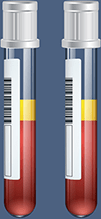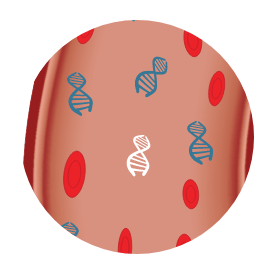Early pregnancy symptoms: One way you’re showing!
A missed period and a pregnancy test often go together. But the first trimester is often also marked by other symptoms that can last for months after a positive pregnancy test result.
While you may be expecting to feel more tired in the first months after the baby is born, feeling tired in the first months after conception can be surprising. Hormonal changes, including increased progesterone levels, are the main reasons you may be nodding off in the afternoon. But your body is also working hard to produce more blood to carry nutrients to your baby, which can mean your blood sugar levels and blood pressure are also lower.
In addition to nutrients, your blood is now carrying fetal DNA.
You may notice your breasts feeling sore or more tender even before you take a pregnancy test—as early as two weeks after conception. Even if you experience breast tenderness around your period, when it’s caused by pregnancy it’s usually more intense and longer lasting. Again, the cause is primarily related to the hormones estrogen and progesterone, but increased blood flow to the breasts also plays a role.
A classic indicator of pregnancy in movies, TV shows, and books, morning sickness affects as many as 90% of pregnant people to some degree. Although scientists don’t know exactly what causes morning sickness (which can happen at any time of the day), the most popular theory is that it’s a reaction to human chorionic gonadotropin (hCG), the pregnancy hormone, which is produced at the highest levels during the first trimester.
Early pregnancy milestones
Your first prenatal appointment
Once you get a positive pregnancy test result, your next move (after telling the person or people you’re closest to) will probably be to make a doctor’s appointment. Your first prenatal appointment usually falls sometime between Weeks 8 and 12 and could be held in person or over the phone, depending on your clinic.
✱
BE PREPARED TO ANSWER QUESTIONS!
The first appointment is all about taking a detailed history to help your clinic ensure they are giving you the pregnancy care you need. Here are five questions on that questionnaire that you should be prepared to answer:
When did your last period start and when did you get a positive pregnancy result?
Have you been pregnant before?
Are there any health conditions that run in your or your partner’s family?
Did your mother have complications during pregnancy and/or birth?
Do you want your baby to be screened for Down syndrome? If yes, be prepared to share your prenatal screening choice now.
It’s a good idea to write down any questions you have. It can be easy to forget your own questions when you are answering someone else’s.
Prenatal screening
Prenatal screening is offered to all pregnant people in Canada as part of their pregnancy care. This includes ultrasounds and the option to have a traditional screening test, a non-invasive prenatal test (NIPT), or no screening at all.
What are your prenatal screening options?
| Harmony test (NIPT using fetal DNA) | Traditional screening test* (maternal serum screening using maternal blood) |
|---|---|
| Available to any pregnant person over age 18. | Available to any pregnant person. |
Test screens for genetic conditions including:
|
Test screens for trisomy 21 (Down syndrome).
|
|
Detects trisomy 21 (Down syndrome) in more than
%
The most accurate prenatal fetal DNA test. |
Detects trisomy 21 (Down syndrome) in
%
|
|
False-positive rate of < 1 in 1,600 meaning fewer pregnant people are referred for unnecessary additional tests.1 |
False-positive rate of 1 in 20 leading to unnecessary worry and additional testing.1 |
Steps and timeline
|
Path with the Harmony test
|
Path for traditional screening
|
|---|---|
|
Single blood test: As early as Week 10 (Can be done before or after the first-trimester ultrasound.) Results within 7–10 business days. |
First blood test: Between Weeks 10 and 13‡ |
| FIRST-TRIMESTER ULTRASOUND OFFERED | |
| That’s it, you’re done! ✱ |
Second blood test: Between Weeks 14 and 16‡ |
Choosing Harmony means choosing earlier results you can trust, giving you peace of mind as you prepare for the future.
What do the test results mean?
Regardless of the screening test you choose, your pregnancy care provider will explain your results and, if necessary, walk you through your options or next steps.
| Harmony test | Traditional screening |
|---|---|
| Results are presented as “high” or “low” risk for each of the conditions the test covers. Plus, it can tell you the baby’s sex. (Note that you can opt out of fetal sex analysis if you want.) | Results indicate whether your baby has a “high” or a “low” probability of being born with trisomy 21 (Down syndrome). |
|
A low-risk result indicates a low likelihood that the pregnancy is affected with the specific condition tested. |
A low-probability result indicates a low likelihood that your baby will be born with trisomy 21 (Down syndrome). |
|
A high-risk result indicates an increased likelihood that the pregnancy is affected with the specific condition tested. |
A high-probability result indicates a high likelihood that your baby will be born with trisomy 21 (Down syndrome). |
| If your result shows high risk, your doctor may refer you to a genetic counsellor and/or for a diagnostic test (such as amniocentesis). | If you get a high-probability result, your doctor may refer you to a genetic counsellor and/or for an NIPT or an invasive diagnostic test (such as amniocentesis). |
*Depending on your province of residence, this test may be referred to as “multiple marker screening (MMS),” “serum integrated prenatal screening (SIPS),” an “integrated screening test,” or simply a “prenatal screening test.”
†22q11.2 deletion syndrome (also called 22q DS or 22q11 DS, among other names) affects as many as 1 in 2,000 to 1 in 4,000 children worldwide.
‡Whether you have blood drawn once or twice depends on your province of residence.
Amniocentesis, sometimes called an “amnio,” is a diagnostic test performed between 15 and 20 weeks of pregnancy to confirm whether your baby has trisomy 21 (Down syndrome). It involves a small-gauge needle being inserted into your abdomen and collecting a sample of amniotic fluid, which is then analyzed in a lab. This kind of “invasive” test does come with additional concerns: Although the risk is low, about 1–2 out of 200 pregnant people will have a miscarriage after amniocentesis (1–2 out of 100 in the case of twin pregnancy).
Increasingly, provinces are providing an NIPT, including Harmony, after traditional screening shows a high probability of trisomy 21. If the NIPT also comes back with a high-risk result, you will be offered diagnostic testing, including amniocentesis.
You’re showing on the inside: See how much Harmony can show you


The Harmony test looks at the cell-free DNA of the baby present in the mother’s bloodstream.

By looking at the baby’s DNA, the Harmony test can provide accurate information about the likelihood for the most common chromosomal conditons, such as:
- Trisomy 21 (Down syndrome)
- Trisomy 18
- Trisomy 13
- 22q11.2 deletion syndrome
- Other chromosomal and sex aneuploidies
The Harmony test can also detect the baby’s sex.
**The Harmony test is covered by provincial health plans in Ontario, British Columbia, and Yukon Territory for various criteria decided by the province. The Harmony test is also covered by some private insurance plans. Contact your plan provider for more details.
Congratulations!
You’re definitely showing!
Get to know your baby better and sooner with Harmony. Ask for the Harmony test by name during your next prenatal visit!
The Harmony test is widely available across Canada through a vast network of providers.
Download the question guide and prenatal fetal DNA test referral form to take with you to your first prenatal appointment.